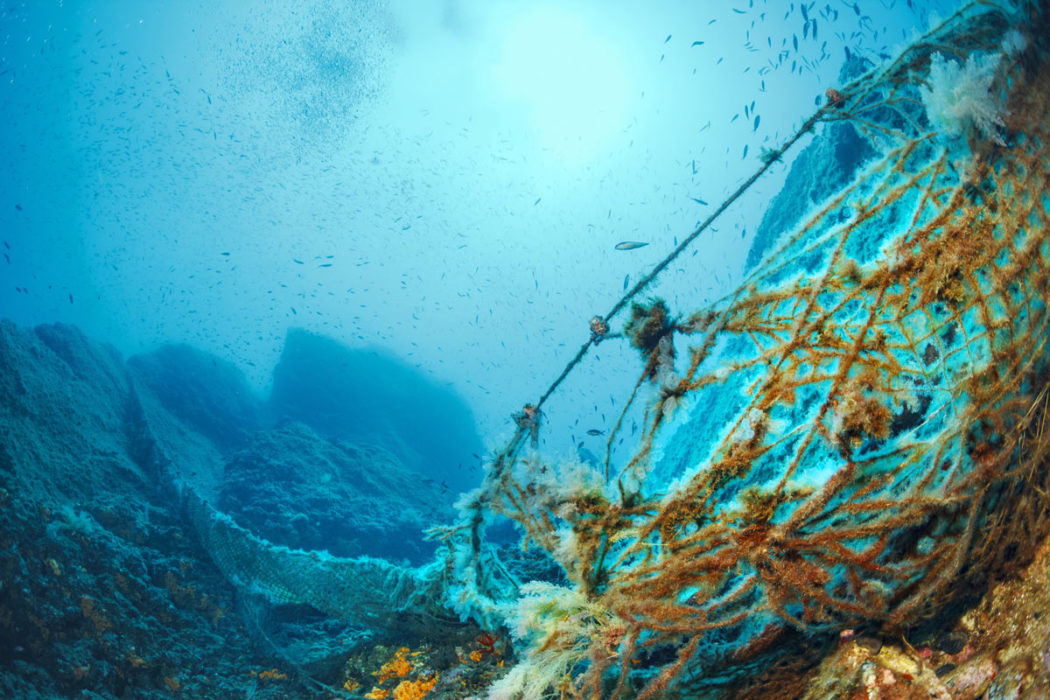The term “Ghost Nets” was coined to describe abandoned, lost or otherwise discarded fishing gear (primarily nets) in the oceans and lakes by fisherman. The nets are often nearly invisible and can be left to tangle on reefs or to drift for miles in open water. They can ensnare turtles, dolphins, whales, manatees, seals, sharks, crocodiles, sea birds, fish and even divers upon occasion. These errant nets continue to do their jobs unchecked and never cease wreaking havoc, causing starvation, lacerations and infection or drowning those animals that need to return to the surface to breathe.
Ghost Fishing is what that fishing gear does when it is no longer under control. Nets, long lines, fish traps or any man-made structure designed to catch fish or marine organisms are considered capable of ghost fishing when unattended. According to the SeaDoc Society, each ghost net kills $20,000 worth of Dungeness crab over 10 years. The Virginia Institute of Marine Science calculated that ghost crab pots capture 1.25 million blue crabs each year just in the Chesapeake Bay. No one will profit from those catches and they will continue to affect what may already be depleted commercial fish stocks. In nets, the caught fish die and in turn attract scavengers which come to feed will get caught in that same net, creating a vicious and deadly cycle.
Hundreds of miles of nets get lost every year and, due to the nature of the materials used to produce these nets they can and will keep fishing for decades and may take up to 600 years to decompose. There is an estimated 640,000 tons (1.28 billion pounds) of fishing gear that becomes lost or discarded in the oceans each year — making up approximately 10 percent of all marine litter.
Some of the nets are abandoned by their owners because they are no longer able to do their jobs due to damage or age — and they find it “cost effective” to simply leave them behind rather than paying for disposal. To combat this, the Fishing for Energy partnership, NOAA, National Fish and Wildlife Foundation, Covanta Energy Corporation, and Schnitzer Steel Industries, Inc. a cost-free solution is provided to fishermen to dispose of old, derelict or unusable fishing gear and to reduce the amount of derelict fishing gear in and around coastal waterways.
The NOAA Marine Debris Program is working with fishermen to provide a place to dispose of fishing gear free of charge and support new, innovative prevention strategies through technological advancements in fishing gear. These solutions will help prevent derelict fishing gear. The program has collected more than 2.1 million pounds of gear from 41 locations across the United States.
In the Caribbean, a Fishing for Energy grant was awarded to The Ocean Foundation to work with the Puerto Rico Department of Natural and Environmental Resources to address derelict fishing traps in Puerto Rico. Divers in this area noticed that there was a high amount of unauthorized fishing traps which are causing damage to the local coral reef. The project partners will work with the community and local government to remove these traps, improve the health of the marine environment and improve compliance with trap fishing regulations.
Another Fishing for Energy grant was awarded to the Island Trails Network in Alaska to reduce the occurrence of entanglement and mortality of marine mammals, while increasing public awareness of the negative impacts of marine mammal entanglement. As part of this project, derelict fishing gear will be removed from locations in the Kodiak archipelago, using small boats to access remote shorelines.
There are some viable solutions to the ghost problem. Biodegradable fishing nets, such as those made from coconut fiber (known as “coir”) are being commercially made and could be a practical solution that fisherman could use. Technology systems for marking and tracking fishing gear, including GPS tracking, are being utilized to promote greater accountability. The Virginia Institute of Marine Science has been awarded a grant to develop technology that allows escape panels on the lost trap to dissolve overtime, freeing captured animals and preventing captures in the future. The project will also develop solutions for fishermen that have lost crab traps to reduce the financial impacts of purchasing new traps.
Fishing nets are often made from extremely high quality plastics to ensure suitable strength, which makes them desirable for recycling. There are companies within the diving industry that use old nets to produce some of their products. Over the past five years, organizations and companies throughout the world have been working together under the Healthy Seas initiative to clean oceans of fishing nets and then recycle the nets into sustainable apparel. Aquafil opened its first U.S.-based carpet recycling facility in Phoenix, Arizona. Old carpets broken down into nylon will be shipped to a Slovenian facility to be converted, together with fishing nets, into yarn for the fashion and interior industries, the company says. According to Aquafil’s research, one ton of nylon nets can create 26,000 socks.
The problem of Ghost Nets is a real and ongoing one. And, although there are potential solutions, they are not without difficulties and associated costs. Retrieving the derelict nets and traps take manpower and dedicated equipment but there is room for a single scuba diver to make a difference locally or to team with larger groups to make a global impact. There are many organizations that are currently striving to make a change. Do your research to determine which matches up with your goals and volunteer. Visit mission-blue.org, part of the Sylvia Earle Alliance, as a starting point.





